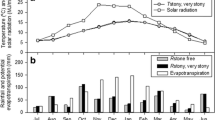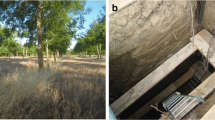Abstract
The hypothesis of niche complementarity for the use of soil resources is crucial for the performance of agroforestry systems. Our aim was to test the hypothesis that roots of 2 years old peach trees intercropped with grass can extract deep soil water below a shallow lithic discontinuity, composed of a layer of pebbles in a powdery calcareous matrix and that hardens in dry conditions. A peach tree orchard was planted on a soil with an average 0.5 m deep lithic discontinuity. Soil water content was measured every fortnight on the row and the inter-row with a neutron probe every 0.2 m up to 3 m depth. The contribution of each soil layer to trees and grass transpiration was simulated with a dynamic water balance model. Results show that tree roots grew through the lithic discontinuity and accessed a water refilled soil layer beneath it only 2 years after plantation, whereas grass roots did not grow below 0.5 m. Soil water content decrease up to 2 m depth after the cessation of irrigation was analysed as the result of tree water uptake. Tree water uptake simulations showed that soil layers below 1 m can contribute up to 17% of the total water uptake of the 2 years old trees. Our results suggest that a lithic discontinuity such as the one in our study may not be an impediment to the perennial trees root growth allowing them to access deep soil water. This suggests that soils with such a lithic discontinuity may be suitable for dryland agroforestry in which deep soil water available to the trees may help in reducing competition for water.








Similar content being viewed by others
Notes
Guo and Zhao (2020) did not state the age of the trees but their diameter (0.36 ± 4 m) and their height (12 m), from which we inferred their mature status.
References
Allen RG, Pereira LS, Smith M, Raes D, Wright JL (2005) Dual crop coefficient method for estimating evaporation from soil and application extensions. J Irrig Drain Eng 131:2–13
Balandier P, De Montard FX, Curt T, Batish D, Kohli R, Jose S, Singh DH (2008) Root competition for water between trees and grass in a silvopastoral plot of 10 year old Prunus avium. In: Jose S et al (eds) Ecological basis of agroforestry. CRC Press, Boca Raton, pp 253–270
Bécel C (2010) Croissance racinaire en verger de pêchers. Influence de la distribution de l’eau dans le sol et de la disponibilité en assimilats carbonés (Doctoral dissertation). Retrieved from HAL archives-ouvertes.fr. Accesssion N° 2010AVIG0627
Bertrand N, Roux S, Forey O, Guinet M, Wery J (2018) Simulating plant water stress dynamics in a wide range of bi-specific agrosystems in a region using the BISWAT model. Eur J Agron 99:116–128
Bordas J (1954) Comment étudier le milieu cultural. Econ Rurale 19:25–33
Cardinael R, Mao Z, Prieto I, Stokes A, Dupraz C, Kim JH, Jourdan C (2015) Competition with winter crops induces deeper rooting of walnut trees in a Mediterranean alley cropping agroforestry system. Plant Soil 391(1–2):219–235. https://doi.org/10.1007/s11104-015-2422-8
Cairns JE, Audebert A, Townend J, Price AH, Mullins CE (2004) Effect of soil mechanical impedance on root growth of two rice varieties under field drought stress. Plant Soil 267(1):309–318. https://doi.org/10.1007/s11104-005-0134-1
Chang SX, Amatya G, Beare MH, Mead DJ (2002) Soil properties under a Pinus radiata–ryegrass silvopastoral system in New Zealand. Part I. Soil N and moisture availability, soil C, and tree growth. Agrofor Syst 54(2):137–147. https://doi.org/10.1023/A:1015040006181
Dobriyal P, Qureshi A, Badola R, Hussain SA (2012) A review of the methods available for estimating soil moisture and its implications for water resource management. J Hydrol 458–459:110–117
FAO and IUSS (2015) World Soil Resources Reports. FAO, Rome, No. 106
Forey O, Metay A, Wery J (2016) Differential effect of regulated deficit irrigation on growth and photosynthesis in young peach trees intercropped with grass. Eur J Agron 81:106–116
Forey O, Temani F, Wery J, Jourdan C, Metay A (2017) Effect of combined deficit irrigation and grass competition at plantation on peach tree root distribution. Eur J Agron 91:16–24
Giambelluca TW, Mudd RG, Liu W, Ziegler AD, Kobayashi N, Kumagai T, Miyazawa Y, Lim TK, Huang M, Fox J et al (2016) Evapotranspiration of rubber (Hevea brasiliensis) cultivated at two plantation sites in Southeast Asia. Water Resour Res 52:660–679
Guo H, Zhao Y (2020) Using isotopic labelling to investigate root water uptake in an alley cropping system within Taklimakan Desert Oasis, China. Agrofor Syst. https://doi.org/10.1007/s10457-020-00527-0
Hodge A (2006) Plastic plants and patchy soils. J Exp Bot 57:401–411
Isaac ME, Anglaaere LCN, Borden K, Adu-Bredu S (2014) Intraspecific root plasticity in agroforestry systems across edaphic conditions. Agric Ecosyst Environ 185:16–23
Jose S, Gillespie AR, Seifert JR, Biehle DJ (2000) Defining competition vectors in a temperate alley cropping system in the midwestern USA: 2. Competition for water. Agrofor Syst 48(1):41–59. https://doi.org/10.1023/A:1006289322392
Kramer PJ, Boyer JS (1995) Water relations of plants and soils. Academic Press, Cambridge
Kulmatiski A, Beard KH (2013) Root niche partitioning among grasses, saplings, and trees measured using a tracer technique. Oecologia 171:25–37
Levillain J, Thongo MBou, A, Deleporte P, Saint-André L, Jourdan C (2011) Is the simple auger coring method reliable for below-ground standing biomass estimation in Eucalyptus forest plantations? Ann Bot 108:221–230
Markewitz D, Devine S, Davidson EA, Brando P, Nepstad DC (2010) Soil moisture depletion under simulated drought in the Amazon: impacts on deep root uptake. New Phytol 187:592–607
Munné-Bosch S (2014) Perennial roots to immortality. Plant Physiol 166:720–725
Ogle K, Wolpert RL, Reynolds JF (2004) Reconstructing plant root area and water uptake profiles. Ecology 85:1967–1978
Parker ML, Perry RL (1993) Orchard floor management affects peach rooting. J Am Soc Hortic Sci 118:714–718
Plamboeck H, Grip H, Nygren U (1999) A hydrological tracer study of water uptake depth in a Scots pine forest under two different water regimes. Oecologia 119:452–460
Rambal S (1984) Water balance and pattern of root water uptake by a Quercus coccifera L. evergreen srub. Oecologia 62:18–25
Romero-Saltos H, Sternberg L, da SL, Moreira, M.Z., and Nepstad DC (2005) Rainfall exclusion in an eastern Amazonian forest alters soil water movement and depth of water uptake. Am J Bot 92:443–455
Schenk HJ (2008) Soil depth, plant rooting strategies and species’ niches. New Phytol 178:223–225
Snowdon P, Raison J, Keith H, Ritson P, Grierson P, Adams M, Montagu K, Bi H, Burrows W, Eamus D (2002) Protocol for sampling tree and stand biomass. National Carbon Accounting System, Technical Report No. 31. Australian Greenhouse Office
van Noordwijk M, Lawson G, Hairiah K, Wilson J (2015) Root distribution of trees and crops: competition and/or complementarity [Chapter 8]. In: Ong CK, Black CR, Wilson J (eds) Tree-crop interactions: agroforestry in a changing climate. 2nd edn. Wallingford, UK, CAB International, pp 221–257
Wanvestraut RH, Jose S, Nair PKR, Brecke BJ (2004) Competition for water in a pecan (Carya illinoensis K. Koch)–cotton (Gossypium hirsutum L.) alley cropping system in the southern United States. Agrofor Syst 60(2):167–179
Weaver JE (1926) Root development of field crops. McGraw-Hill Book Company, Inc, New York
Weaver JE, Crist JW (1922) Relation of hardpan to root penetration in the Great Plains. Ecology 3(3):237249
Wu Q, Pagès L, Wu J (2016) Relationships between root diameter, root length and root branching along lateral roots in adult, field-grown maize. Ann Bot 117:379–390
Yocum WW (1937) Root development of young delicious apple trees as affected by soils and by cultural treatments. College of Agriculture, University of Nebraska, Agricultural experiment station research bulletin 95. Historical Materials from University of Nebraska-Lincoln Extension. Paper 910
Zhang W, Ahanbieke P, Wang BJ, Gan YW, Li LH, Christie P, Li L (2015) Temporal and spatial distribution of roots as affected by interspecific interactions in a young walnut/wheat alley cropping system in northwest China. Agrofor Syst 89(2):327–343. https://doi.org/10.1007/s10457-014-9770-x
Acknowledgements
This work was supported by the Fondation de France. We would like to thank the UMR System and UE Diascope staffs for their technical support.
Author information
Authors and Affiliations
Corresponding author
Additional information
Publisher’s Note
Springer Nature remains neutral with regard to jurisdictional claims in published maps and institutional affiliations.
Rights and permissions
About this article
Cite this article
Forey, O., Metay, A., Bertrand, N. et al. Two years old peach trees intercropped with a grass mixture can grow through a lithic discontinuity to access water the grass cannot. Agroforest Syst 95, 151–163 (2021). https://doi.org/10.1007/s10457-020-00579-2
Received:
Accepted:
Published:
Issue Date:
DOI: https://doi.org/10.1007/s10457-020-00579-2




